Development and Application of Tree Radial Measurement Device
Abstract
:1. Introduction
2. Device Development
2.1. Mechanical Structural Design
2.2. Circuit Design
2.2.1. Master Module
2.2.2. Communication Timing Module
2.2.3. Data Acquisition and Storage Module
2.2.4. Power Module
2.3. Principle of the Device
2.3.1. Principle of Operation of the Device
2.3.2. Sensor Selection
2.3.3. Magneto-Resistive Effect
2.3.4. Principle of Diameter Calculation
2.3.5. Principle of Accuracy Calculation
3. Software Design
4. Testing and Analysis
4.1. Trial Sites and Subjects
4.1.1. Sample Plot Selection
- (1)
- Sample plots are reasonably distributed and representative of mixed broadleaf and mixed conifer forests;
- (2)
- Good communication conditions around the monitoring sample sites.
4.1.2. Sample Tree Selection
4.2. Analysis of Monitoring Data
4.2.1. Analysis of the Growth Process of Single Wood Diameter at Breast Height
4.2.2. Accurate Calculation of Carbon Sinks for Individual Trees
5. Results
- (1)
- In this paper, a low-power, high-precision tree breast diameter continuous measurement device is developed. A high-resolution and low-cost processing algorithm is proposed based on the magneto-resistive effect and, combined with the self-developed electromechanical structure design, it realizes the conversion of mechanical rotation into electrical signals, which is then converted into the amount of change in the diameter of the chest. The matching system software was also developed for the visual analysis of tree diameter at breast height and carbon sinks as well as data management functions such as storage and uploading. It has been verified that the device has the characteristics of low power consumption, portable structure, strong anti-interference, etc. The outdoor working hours can last for more than 12 months. Through the traditional tree diameter measurement method, the tree diameter tape measure is utilized to measure the tree diameter, the measurement results are compared with the measured value of the device, and the monitoring error is calculated to be within 0.1%. The frequency of data acquisition is set at 1 h, and the data is saved locally, while real-time data is transmitted to the host computer platform every 12 h.
- (2)
- Data analysis shows that the overall growth pattern of trees is roughly the same, the rapid growth period of trees in the test area is roughly from late April to early July, and the dormant period of trees is from October to February of the following year. Combined with its environmental factors, it can be concluded that there is a correlation between changes in tree diameter at breast height and temperature and relative humidity. A 4.87 m tall tree with a diameter at breast height of 126.4 mm in the test area increased carbon sinks by 0.005427 from March to September, which can absorb the carbon emissions of a car traveling for one day.
6. Conclusions
Author Contributions
Funding
Data Availability Statement
Conflicts of Interest
References
- Wang, Z.; Feng, Z.; Yan, F.; Ma, T.; Zheng, J.; Wang, M. Integrated Indoor and Field Forest Measurement by Using Total Station. J. Northwest For. Univ. 2013, 28, 134–138. [Google Scholar]
- Mokroš, M.; Liang, X.; Surový, P.; Valent, P.; Čerňava, J.; Chudý, F.; Tunák, D.; Saloň, Š.; Merganič, J. Evaluation of Close-Range Photogrammetry Image Collection Methods for Estimating Tree Diameters. ISPRS Int. J. Geo-Inf. 2018, 7, 93. [Google Scholar] [CrossRef]
- Srinivasan, S.; Popescu, S.C.; Eriksson, M.; Sheridan, R.D.; Ku, N.-W. Terrestrial Laser Scanning as an Effective Tool to Retrieve Tree Level Height, Crown Width, and Stem Diameter. Remote Sens. 2015, 7, 1877–1896. [Google Scholar] [CrossRef]
- Cabo, C.; Ordóñez, C.; López-Sánchez, C.A.; Armesto, J. Automatic Dendrometry: Tree Detection, Tree Height and Diameter Estimation Using Terrestrial Laser Scanning. Int. J. Appl. Earth Obs. Geoinf. 2018, 69, 164–174. [Google Scholar] [CrossRef]
- Briggs, D.; Ingaramo, L.; Turnblom, E. Number and Diameter of Breast-Height Region Branches in a Douglas-Fir Spacing Trial and Linkage to Log Quality. For. Prod. J. 2007, 57, 28. [Google Scholar]
- Sun, L.; Fang, L.; Weng, Y.; Zheng, S. An Integrated Method for Coding Trees, Measuring Tree Diameter, and Estimating Tree Positions. Sensors 2020, 20, 144. [Google Scholar] [CrossRef] [PubMed]
- Yu, D.; Feng, Z.; Cao, Z.; Jiang, J. Error Analysis of Measuring Diameter at Breast Height and Tree Height and Volume of Standing Tree by Total Station. J. Agric. Eng. 2016, 32, 160–167. [Google Scholar]
- Sievänen, R.; Godin, C.; DeJong, T.M.; Nikinmaa, E. Functional–Structural Plant Models: A Growing Paradigm for Plant Studies. Ann. Bot. 2014, 114, 599–603. [Google Scholar] [CrossRef] [PubMed]
- Moe, K.T.; Owari, T.; Furuya, N.; Hiroshima, T.; Morimoto, J. Application of UAV Photogrammetry with LiDAR Data to Facilitate the Estimation of Tree Locations and DBH Values for High-Value Timber Species in Northern Japanese Mixed-Wood Forests. Remote Sens. 2020, 12, 2865. [Google Scholar] [CrossRef]
- Dalla Corte, A.P.; Rex, F.E.; de Almeida, D.R.A.; Sanquetta, C.R.; Silva, C.A.; Moura, M.M.; Wilkinson, B.; Zambrano, A.M.A.; da Cunha Neto, E.M.; Veras, H.F. Measuring Individual Tree Diameter and Height Using GatorEye High-Density UAV-Lidar in an Integrated Crop-Livestock-Forest System. Remote Sens. 2020, 12, 863. [Google Scholar] [CrossRef]
- Wu, H.; Wang, X.; Liu, C. Tree Diameter at Breast Height Automatic Estimation Based on Forest Terrestrial Laser Scanning. J. Tongji Univ. (Nat. Sci.) 2022, 50, 947–954. [Google Scholar]
- Liu, J. Fast Measurement Method For Tree Diameter at Breast Height Based on Terrestrial Laser Scanning Point Cloud. Intell. Comput. Appl. 2022, 12, 152–157. [Google Scholar]
- Wang, Q. Tree Parameter Extraction and Visualization Based on 3D Laser Scanning Technology. Bachelor’s Thesis, Anhui University, Anhui, China, 2017. [Google Scholar]
- Cheng, P.; Liu, J.; Wang, D. Measuring Diameters at Breast Height Using Combination Method of Laser and Machine Vision. Trans. Chin. Soc. Agric. Mach. 2013, 44, 271–275. [Google Scholar]
- Li, W.; Yue, D.; Zhang, Q. DBH Measurement Algorithm of Tree Measuring Instrument Based on Digital Image Processing Technology. For. Inventory Plan. 2019, 44, 1–10. [Google Scholar]
- Lu, Q.; Yue, D. Digital Image Processing Technology Based Dendrometer Algorithm. J. Northwest For. Univ. 2018, 33, 149–155. [Google Scholar]
- Sun, Y.; Fang, L.; Yu, H.; Zheng, S.; Yuan, F.; Lou, X. Development of Double⁃Angle Laser Measuring Device for Stand Diameter at Breast Height. Chin. J. Sens. Actuators 2023, 36, 990–998. [Google Scholar]
- Li, S.; Fang, L.; Sun, Y.; Xia, L.; Lou, X. Development of Measuring Device for Diameter at Breast Height of Trees. Forests 2023, 14, 192. [Google Scholar] [CrossRef]
- Li, Q.; Dong, L.; Li, D.; Liu, X. Design of a Portable Device for Measuring DBH of Trees. For. Mach. Woodwork. Equip. 2023, 51, 24–27. [Google Scholar]
- Type D Tree Chest Diameter Growth Measurement Rings [EB/OL]. Available online: https://m.instrument.com.cn/pic/C397254.html (accessed on 26 September 2024).
- European DD-L Series [EB/OL]. Available online: https://www.instrument.com.cn/show/C369060.html (accessed on 26 September 2024).
- Asia DE Series [EB/OL]. Available online: https://www.instrument.com.cn/show/C392045.html (accessed on 26 September 2024).
- Yuan, F. Development of the Continuous Measurement System for the Tree Diameter at Breast Height. Bachelor’s Thesis, Zhejiang Agriculture and Forestry University, Zhejiang, China, 2021. [Google Scholar] [CrossRef]
- Zhao, R. Design and Realization of High-Resolution and High-Accuracy Magnetic Encoder Based on TMR. Bachelor’s Thesis, Hangzhou University of Electronic Science and Technology, Zhejiang, China, 2021. [Google Scholar] [CrossRef]
- Liu, J. Research on Small Current Sensor Based on Tunnel Magnetoresistance Effect. Bachelor’s Thesis, Nanjing University of Science and Technology, Nanjing, China, 2021. [Google Scholar] [CrossRef]
- Sun, S. Researches on the Technology of Servo Motor Magnetic Encoder Based on TMR Sensor. Bachelor’s Thesis, Hangzhou University of Electronic Science and Technology, Zhejiang, China, 2016. [Google Scholar]


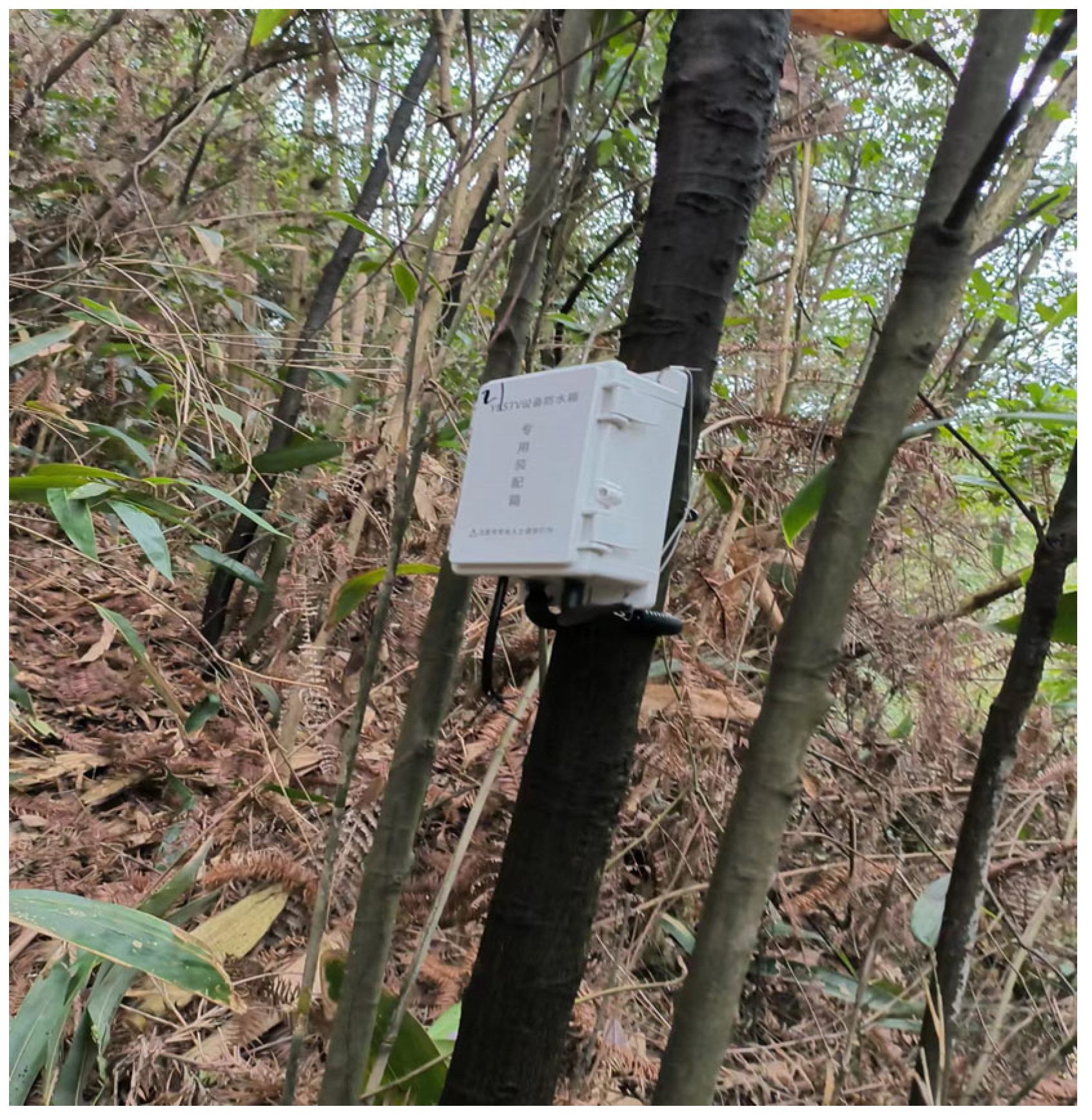





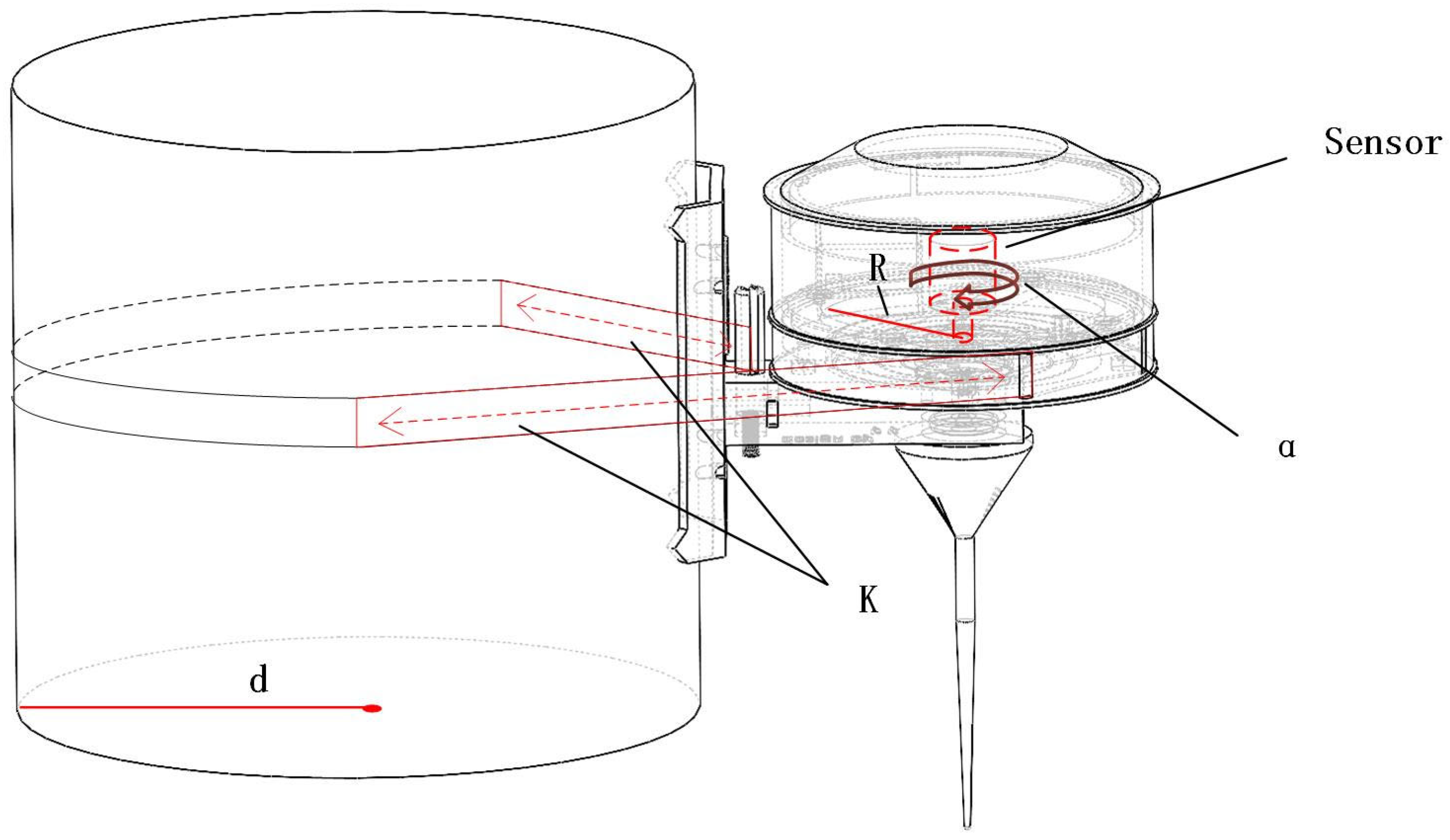
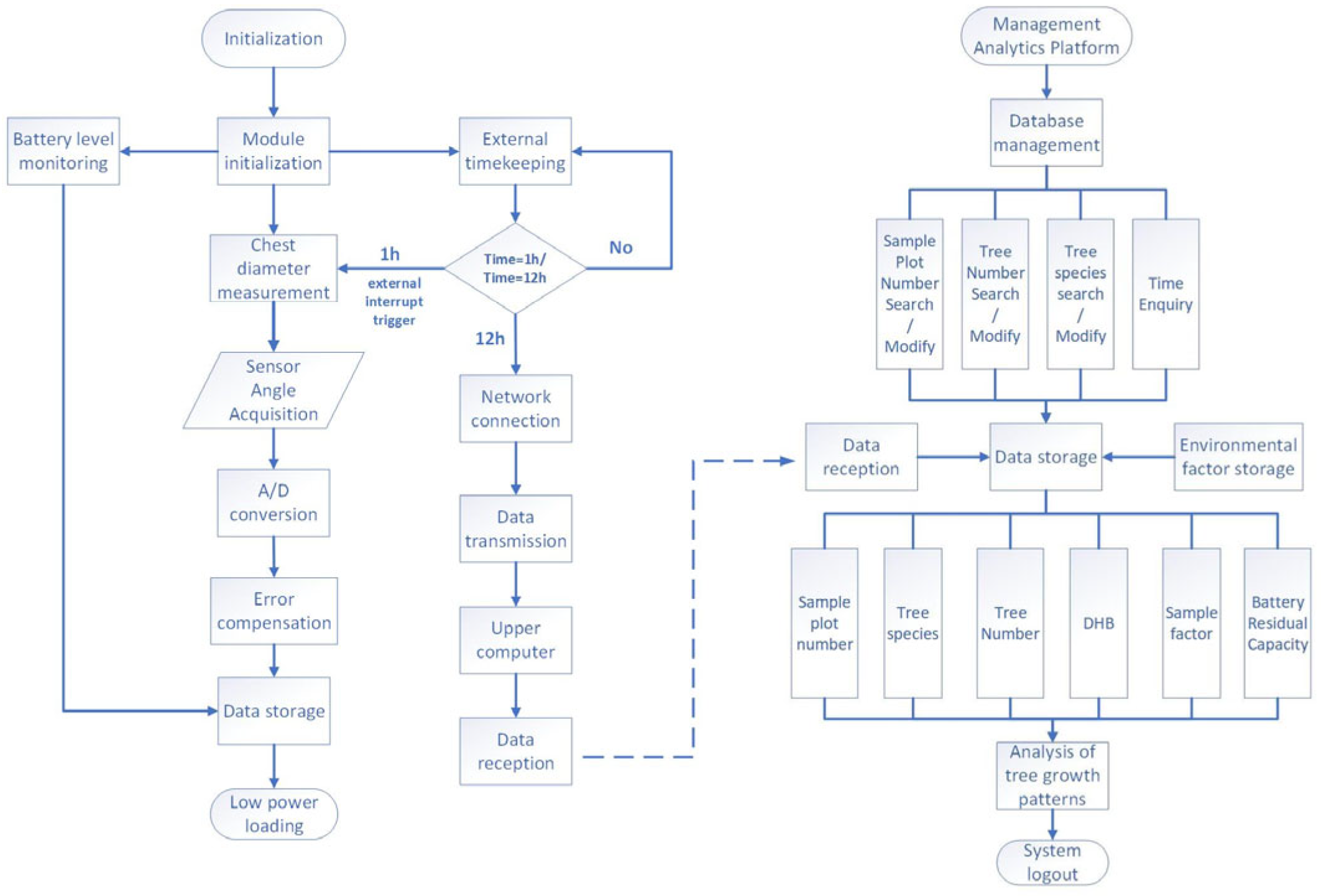
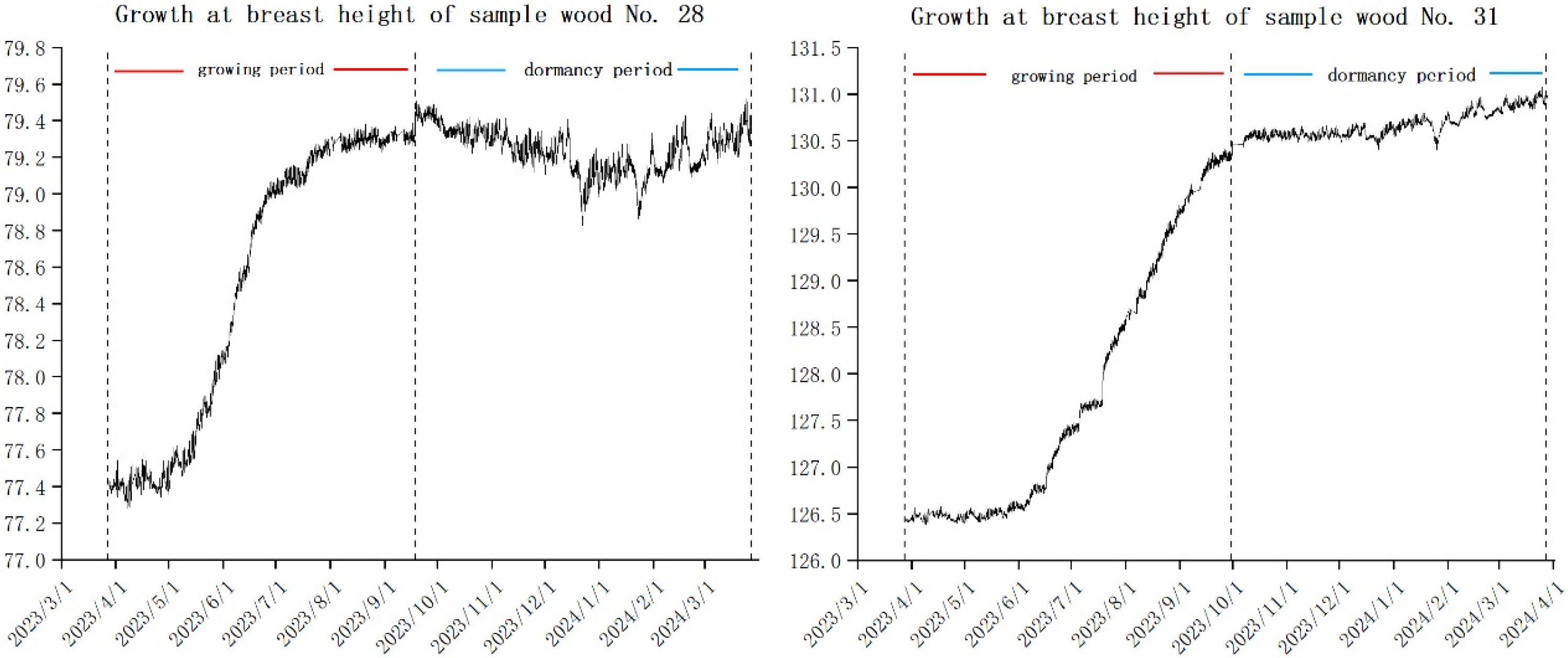
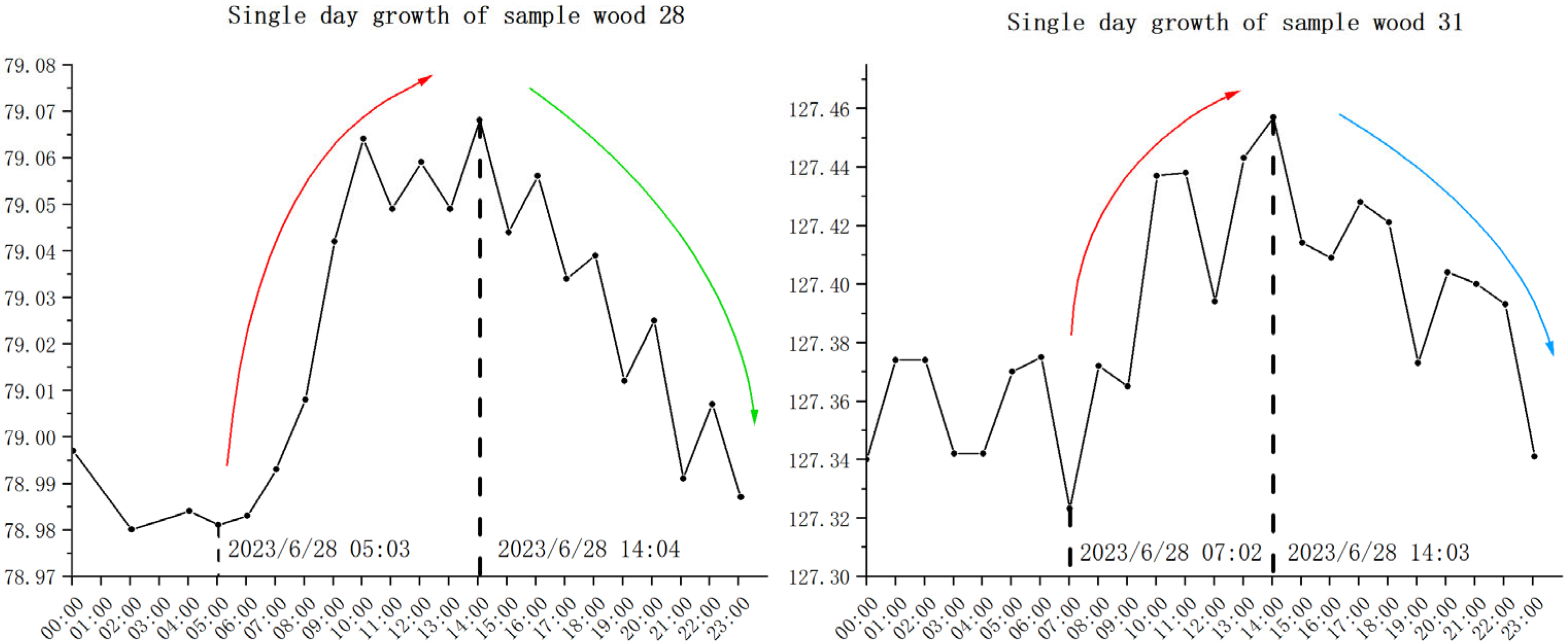
| Tree Species | Monitoring Values | Actual Measured Value | Oscillometric Error |
|---|---|---|---|
| Cedar | 86.449 | 87 | −0.551 |
| Symplocos lucida | 78.201 | 78.8 | −0.599 |
| Quercus fabri Hance | 61.231 | 62.1 | −0.869 |
| Metasequoia | 134.417 | 134.1 | 0.317 |
| Emmenopterys henryi | 111.099 | 111.4 | −0.301 |
| Maple | 79.387 | 79.9 | −0.513 |
| Wood lotus | 130.82 | 131.5 | −0.68 |
| Albizzia julibrissin | 101.139 | 101.5 | −0.361 |
| Pinus massoniana | 219.084 | 219.7 | −0.616 |
| Lindera glauca | 54.399 | 54.9 | −0.501 |
| Number | Tree Species | DBH (mm) | Tree Height (m) | Crown Width (m) |
|---|---|---|---|---|
| 1 | Maple | 77.43 | 3.95 | 3.6 |
| 2 | Wood lotus | 126.45 | 4.87 | 3.3 |
| Tree Species | Carbon Sinks by Month (Tons) | Total Carbon Sink Enhancement (Tons) | ||||||
|---|---|---|---|---|---|---|---|---|
| March | April | May | June | July | August | September | ||
| Maple | 0.0000772 | 0.0003089 | 0.0003862 | 0.0009657 | 0.0007725 | 0.0005794 | 0.0002575 | 0.003862 |
| Wood lotus | 0.0001085 | 0.0004342 | 0.0005427 | 0.001628 | 0.001302 | 0.0009768 | 0.0004342 | 0.005427 |
Disclaimer/Publisher’s Note: The statements, opinions and data contained in all publications are solely those of the individual author(s) and contributor(s) and not of MDPI and/or the editor(s). MDPI and/or the editor(s) disclaim responsibility for any injury to people or property resulting from any ideas, methods, instructions or products referred to in the content. |
© 2024 by the authors. Licensee MDPI, Basel, Switzerland. This article is an open access article distributed under the terms and conditions of the Creative Commons Attribution (CC BY) license (https://creativecommons.org/licenses/by/4.0/).
Share and Cite
Zhao, K.; Li, S.; Wang, J.; Sun, L.; Fang, L.; Ji, J. Development and Application of Tree Radial Measurement Device. Forests 2024, 15, 1710. https://doi.org/10.3390/f15101710
Zhao K, Li S, Wang J, Sun L, Fang L, Ji J. Development and Application of Tree Radial Measurement Device. Forests. 2024; 15(10):1710. https://doi.org/10.3390/f15101710
Chicago/Turabian StyleZhao, Kejie, Shangyang Li, Jie Wang, Linhao Sun, Luming Fang, and Jingyong Ji. 2024. "Development and Application of Tree Radial Measurement Device" Forests 15, no. 10: 1710. https://doi.org/10.3390/f15101710





